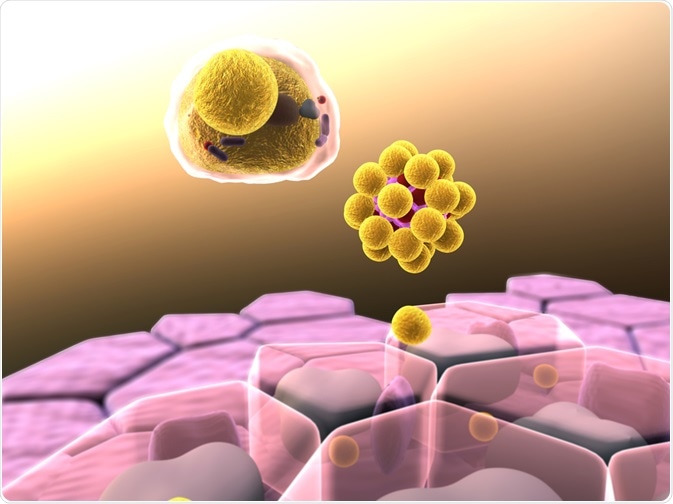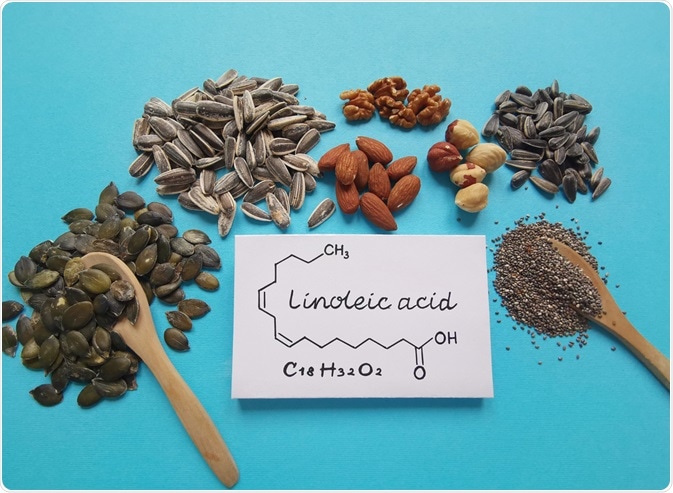An overview of fatty acids
Fatty acids, which represent a substantial part of lipids in the human body, are important sources of energy. Fatty acids can either be saturated or unsaturated carboxylic acids containing carbon chains between 2 and 36 carbon atoms in length. Although more than 60 fatty acids have been identified in the blood plasma and tissues, only a fraction are biologically relevant.

Image Credit: UGREEN 3S / Shutterstock.com
The large body of epidemiological evidence about total fat content, fatty acids and human health show that major groups of fatty acids are associated with diverse health effects. When the diet lacks adequate amounts of specific fatty acids, deficiency symptoms will arise as specific clinical entities. Conversely, increased content of saturated fatty acids may result in dyslipidemia.
The two main fatty acids that are essential in the diet are linoleic acid, which is otherwise referred to as omega-6, and alpha-linolenic acid, or omega-3. Both linoleic and alpha-linolenic acids are polyunsaturated fatty acids, which means that they possess two or more double bonds and lack several hydrogen atoms that are otherwise found in saturated fatty acids.
Metabolism of linoleic acid
Linoleic acid maintains the skin's impermeability to water; however, to exert its other effects on the body, linoleic acid must undergo specific metabolic processes. The first step in the metabolism of linoleic acid is converted to gama-linolenic acid by delta-6-desaturation. Gama-linolenic acid is subsequently converted to dihomo-gamma-linolenic acid, which is in turn converted to arachidonic acid.
Arachidonic acid can form prostaglandins and thromboxanes, which are hormone-like lipids that promote blood clotting, induce inflammation and cause smooth muscle contraction. In an alternative pathway, arachidonic acid can also form leukotrienes, which are one of the most potent inflammatory agents in the human body.
The necessity of metabolism for is reflected by the increasing potency of each substance that is eventually formed by this essential fatty acid. Therefore, to achieve a full range of activities, linoleic acid must be metabolized to other substances, which allows this fatty acid to also be considered analogous to provitamins.
In infants, delta-6-desaturase is too immature to provide the desired metabolism of linoleic acid, which is the reason why human milk contains gamma-linoleic acid, dihomo-gamma-linoleic acid, and arachidonic acid. In contrast, conventional infant formulas only provide linoleic and alpha-linolenic acid, which can lead to a deficiency state in formula-fed infants.
Health benefits of conjugated linoleic acids
Conjugated linoleic acids (CLAs) refers to a heterogeneous group of constitutional and geometric isomers of linoleic acid, which are predominantly found in milk, milk products, meat, and meat products of ruminants. The effect of CLAs on human health originally became the subject of interest after one study demonstrated their inhibitory effects on mouse epidermal neoplasia.
CLAs can provoke a wide spectrum of beneficial effects in various in vitro and in vivo models of disease. However, some studies have reported ambiguous or harmful effects of CLA supplementation. Additionally, there is less evidence that has been collected from direct studies on humans; therefore, careful consideration and further investigation are warranted.

Image Credit: Danijela Maksimovic / Shutterstock.com
Research has shown that CLAs have a significant inhibitory effect on the establishment and progression of atherosclerosis in animal models. Both low-density lipoprotein (LDL) cholesterol to high-density lipoprotein (HDL) cholesterol, as well as total cholesterol to HDL cholesterol ratios, are reduced when CLAs are fed to the test animals.
There is also proof that CLAs block the growth and spread of malignant tumors, primarily by influencing cell replication and mechanisms of carcinogenesis. CLAs have also been found to increase the formation of mineralized bones in several experiments.
On the other hand, CLAs have also been found to induce insulin resistance and fatty liver. These results thereby point to the need to conduct a more detailed investigation into the complex network of anti-obesity regulatory pathways to improve the understanding of how exactly CLAs can affect body weight control.
Recommended CLA daily intake is currently between 0.35 and 1 gram (g) per day. More controlled studies of CLA usage in defined populations are needed, as possible health consequences of prolonged treatment periods are unknown at the moment. Mutual comparisons of different and well-defined mixtures of isomers are also essential to secure long-term effects and safety.
References
Further Reading